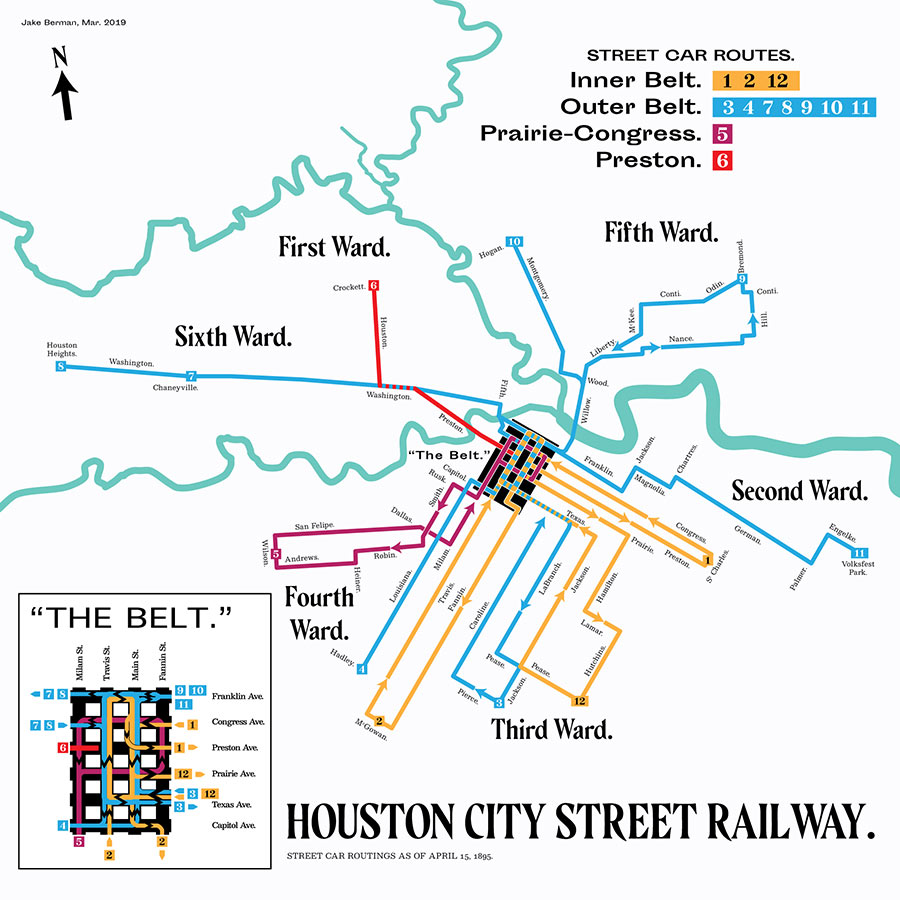COMMENT OF THE DAY: HOW IT WORKS IN HOUSTON, THE FREE ENTERPRISE CITY  “. . . That is, and always has been, Houston. That unruly sprawl, those cookie-cutter suburbs, generic strip malls, traffic congestion, that all existed long before the Beltway was built. I grew up here, in a cookie-cutter suburb called ‘Sagemont’ located next to a 2 lane stretch of blacktop named ‘South Belt.’ My dad grew up in a cookie-cutter suburb 10 miles closer in, filled with generic strip malls, just outside what would become the 610 Loop. Today I live in another cookie-cutter suburb farther west, about half way between 610 and the Beltway. Still lots of congestion, sprawl, strip centers, etc. This is Houston, baby.
And just about everything in Houston exists because some powerful person (not necessarily a politician) owned tracts of land. All of those hip dense neighborhoods? They were empty fields that some speculator bought for next to nothing, then bribed . . . er, influenced someone in government to build something, often with tax dollars. That’s how things get done.” [Memebag, commenting on Driving Beltway 8, in Order To Read Houston in the Original] Illustration: Lulu
“. . . That is, and always has been, Houston. That unruly sprawl, those cookie-cutter suburbs, generic strip malls, traffic congestion, that all existed long before the Beltway was built. I grew up here, in a cookie-cutter suburb called ‘Sagemont’ located next to a 2 lane stretch of blacktop named ‘South Belt.’ My dad grew up in a cookie-cutter suburb 10 miles closer in, filled with generic strip malls, just outside what would become the 610 Loop. Today I live in another cookie-cutter suburb farther west, about half way between 610 and the Beltway. Still lots of congestion, sprawl, strip centers, etc. This is Houston, baby.
And just about everything in Houston exists because some powerful person (not necessarily a politician) owned tracts of land. All of those hip dense neighborhoods? They were empty fields that some speculator bought for next to nothing, then bribed . . . er, influenced someone in government to build something, often with tax dollars. That’s how things get done.” [Memebag, commenting on Driving Beltway 8, in Order To Read Houston in the Original] Illustration: Lulu





Newsflash – real estate in Houston exists because of powerful people owning tracts of land! What an odd peculiarity of a city we are!
All fine if the taxpayer does not have to foot the bill for the roads/infrastructure to make that tract valuable. Up in Montgomery County, this is playing out today with the proposed Woodlands Parkway extension and the upcoming bond vote.
The thing is, vwtogo, suburban roads and other infrastructure subsidies actually do pay back in the long run, in a way that subsidies for transit and infrastructure downtown do not. Opening up cheap suburban land to development, causes the value of that land to skyrocket. In turn the tax assessments go up on that land, and the local government gets more revenue. That money can be used to pay down bonds for infrastructure development.
.
As much as infrastructure renewal (and transit) is an absolute necessity in existing urban neighborhoods, it will never pay for itself this way because renewing infrastructure will not cause the land values around it to go up. To increase land values in urban neighborhoods, the money is better spent on public safety, anti-blight efforts, and overhauling public schools.
.
To me this is a fundamental root of a problem that drives urban sprawl on both the supply and the demand side.
ZAW, just don’t focus too much on roads being used to raise property values only. Quality of roadways and traffic patterns tie in very closely with what you stated to improve safety, blight and everything else They also play a very important role in the mobility and productivity of workers to increase a cities net GDP. You increase the GDP and you have wage growth along with asset inflation which benefits everyone, whether they like to think so or not. Although the benefits in retrofitting older urban roads may not provide as high of returns (and obviously in Houston we could care less about this), targeted infrastructure improvements in old urban areas can still provide very good returns and be more than worthwhile.
***
Everything needs to be interconnected and we should always strive to connect as many people as possible to our cities freeway infrastructure. Economically speaking, sprawling cities are very much favored over small interconnected rural towns or distant exurbs without the means to raise their populations standards of living.
Some of the same thoughts around urban needs should be applied in the suburbs. What good is expansion where that tax base simply funds the bonds, where contributions to mobility or quality of life are not weighed appropriately.
@ZAW
I agree that there is an initial boost in tax revenue from new roads out in the sticks. But what happens after 40 years when all those sprawled-out suburban roads have to be repaired or replaced? As the infrastructure ages, it becomes a burden on local government to maintain. At that point, the low density in those areas creates a situation where a disproportionate amount of money will have to be spent to benefit a relative few amount of tax-paying citizens, who live an area with very high public road mileage per capita. Whereas doing the same type of maintenance/improvement in the urban core, where population density is much higher and road networks are more tightly spaced, benefits more people for less money.
@Superdave: well yes and no. It’s not just about density. It’s a factor of density and tax base. High density doesn’t mean squat if the tax base is low – because a low tax base means there’s not a lot of money for infrastructure repairs, no matter how many people live there.
.
My view is that, in an older neighborhood, the first goal has to be anti-blight measures, improved policing, and overhauled schools. These can ideally be done relatively cheaply (compared to major infrastructure improvements), and ideally they pay off in a higher tax base, The higher tax base means more tax revenue, and that revenue can be capitalized to pay for infrastructure repairs.
You’re all partially right, but joel has the best answer because it relates to regional GDP. If a portfolio of financially-sustainable capital improvements to a city raise its productivity (in VERY broad terms, which may include activities within households as well as firms) then that is a set of options that should be weighed against the universe of possible alternative portfolios of options.
ZAW is a little bit right. Opening up wide swaths of cheap land to development enables the cost of housing to be relatively low. The benefits of that are shared between households that can divert resources to other forms of consumption as well as to firms that bid for labor at a lower local price that still reflects superior purchasing power. Land-intensive firms also directly benefit, of course, so that helps our blue collar sector and aspects of our service sector. However…that DOES NOT mean that every local municipal jurisdiction stands to gain. The benefits of a regional growth-maximization strategy are highly distributive between political jurisdictions and neighborhoods. The matter of paying for repair & maintenance of infrastructure once its built is something that has to be carefully considered and accounted for by the relevant jurisdictions.
Superdave is right to be concerned about R&M and replacement, then, but his concerns should not be limited to any form of infrastructure over another. All infrastructure has a life expectancy that relates to its physical condition. However, we rarely completely replace infrastructure because it is are in danger of catastrophic failure; instead we make repairs. We can do the same thing to infrastructure or to a house or to any other building essentially perpetually, whether it makes economic sense to do so or not. The primary reason that governments make massive expenditures on total infrastructure replacement is that they are FUNCTIONALLY OBSOLESCENT. This can be the result of utilization rates exceeding designed capacity, or it can be the result of technological advancement.
Functional obsolescence is the curse of growth, and that curse is compounded in terms of dollars and cents in an area where land prices are high, and both structures and layers of legacy infrastructure are in the way of curing the problem. The old city was often shaped by old technologies; new technologies don’t always fit in neatly, requiring the geographic displacement of labor and capital. Replacement projects take longer. The disruption to citizens’ lives of replacing infrastructure within an already-congested system is greater; changes that are wrought on culturally-significant parts of a city can be political hot-buttons that bring together otherwise very disunited political groups. The more that is done to actively encourage people to live in cities, the more frequently that functional obsolescence will be a problem; it can even get to where the costs of replacing obsolete infrastructure are outweighed by the disruption of attempting to do so. (Talk to a European civil engineer if you ever want to get an earful about this.) When growing cities get locked into their legacy infrastructures, that diminishes everybody’s lifestyle…with possibly two exceptions: legacy landlords and the developers of low-density communities in Florida where said landlords retire.
Greenfield development, by contrast, is fast and relatively inexpensive. It displaces many fewer people on an involuntary basis, sometimes none at all. Disruptions to layers of other infrastructure are minimal. It certainly does create additional burdens on the regional transportation system, however rights-of-way tend to be established that are broader and lower densities and lower land values make dealing with future functional obsolescence in the suburbs quite a bit less expansive and more focused on particular arterials than they would be if they were tackled in a crowded city.
Having said all of this, I need to make some disclaimers. 1) Greenfield development sometimes does not take place in a manner that fits with a regional transportation strategy. These are missed opportunities. There are many missed opportunities. 2) Yes, I know that if everybody just lived in a dense city that the average commute would be shorter. I do not consider “distance traveled” to be a relevant metric by which to judge infrastructure or human betterment. Such metrics may be a function of distance, but distance all by itself is totally irrelevant in human terms. We need to be weighing opportunities against costs. 3) It is completely rational for a landed interest in the city to press for urban growth boundaries and really any sort of barrier to greenfield development. That could include a big company like Grocers Supply or an individual homeowner in Cottage Grove. Implementing such policies may even be in the collective long-term economic interests of the people that are already voting in local elections right now. I do not believe, however, that these voices reflect the public interest. And actually, I consider them to be potentially very dangerous in terms of social justice.
That’s odd. I can’t understand any of the comments about my comment.